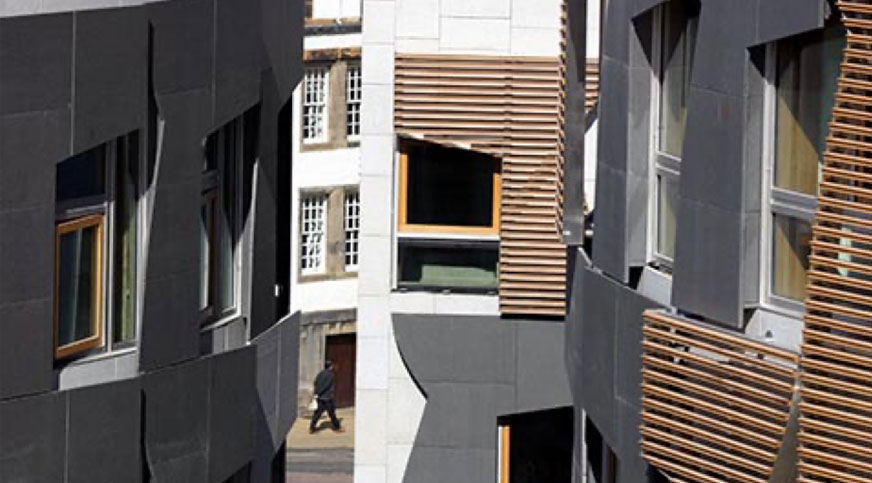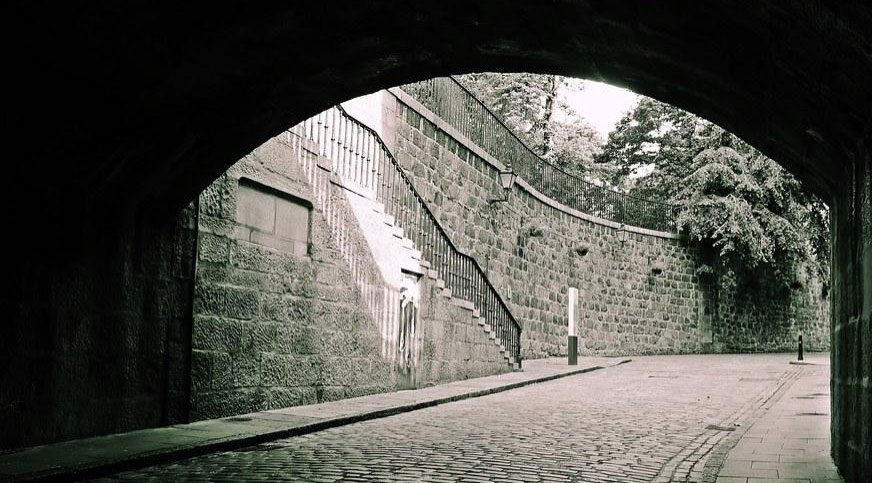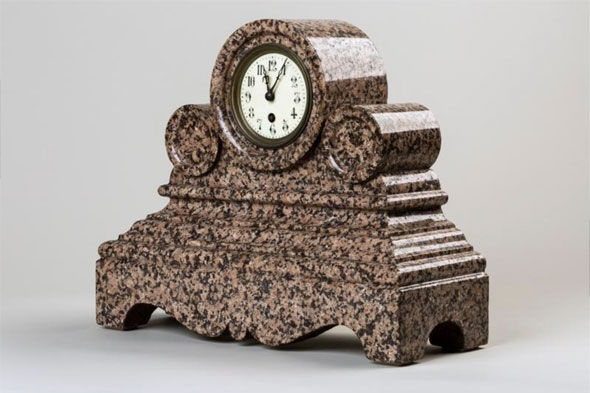Granite is a hard igneous rock known for its durability and resistance to wind and rain. It is predominantly found in the north east of Scotland around Aberdeen, and was used so extensively in the building of many of the city’s buildings that it became known as “The Granite City”. It varies in colour depending on where it was quarried – from the grey Rubislaw granite, to pink Peterhead granite.
As with all stone, granite is the product of millions of years of geological changes. It is primarily composed of the minerals quartz, feldspar, and mica, and forms when volcanic magma or lava cools relatively slowly underground.
Granite is hard enough to resist abrasion, strong enough to bear significant weight, and inert enough to resist weathering which makes it a popular building material.
Granite is predominantly found in the north east of Scotland, especially around the city of Aberdeen. There were once around 150 granite quarries in the area. The colour of granite varies across the region, meaning that many buildings can be dated and the stone traced back to the mining site based on the colour. Rubislaw Quarry was the largest quarry in the area, and it is estimated that at least 50% of Aberdeen’s historical buildings are built from stone from Rubislaw.
There are currently very few granite quarries left in Scotland, and much of the granite used in Scotland is imported. Of the few remaining quarries that do quarry granite, the majority of the granite they produce is smaller, blasted rocks used in the production of aggregates rather than large dimensional stone that is suitable for building. On occasion, they may produce large dimensional blocks of granite for building but this is largely confined to use for prestige buildings in the public realm, such as the Scottish Parliament building.

Although Abderdeen was the main producer of granite in Scotland, it was also quarried in the south of Scotland in Dumfries and Galloway. One notable granite quarry in this area that is still in operation is the Glensanda Super Quarry. It produces granite for aggregate, rather than building stone, and is the largest granite quarry in Europe.
Quarries creating building stone, including granite, were once abundant and could be found across Scotland, but there are now very few left in operation. At their peak in the 19th century, there were thought to be around 2,500 building stone quarries across Scotland, although not all of these would have been producing granite.
Granite is predominantly used as an architectural building material. It can be used to construct the walls of buildings, in the restoration of historical buildings, as cladding on the outside of buildings, and as a hardwearing flooring material. It is also a popular material for gravestones and memorials, and was used extensively to create decorative architectural features such as columns on buildings, and to create statues, monuments and fountains. Granite was also used to produce “setts”, commonly known as cobbles, to create roads and were used to create many of the roads in major cities across Scotland and the rest of the UK, including London. Many of these can still be seen today, especially in historical and conservation areas.

There are also some examples of granite being used for decorative purposes both within the home and as worn accessories, although these aren’t common. Aberdeen Art Gallery and Museum have a small number of these items in their collection – including a granite clock case, and jewellery made from granite and silver including brooch pins and bracelets.


There are currently no granite quarries in operation across Scotland that produce dimensional building stone granite. There are a few in operation producing granite for aggregate, but data on how much granite they produce is unavailable.
The Scottish granite industry hit its peak in the late 1800s, but the quarrying of granite as a building stone dwindled from the mid 20th Century onwards and only a few working quarries remained by the 1970s. This decline was due to various factors including competition from overseas, where granite was able to be produced cheaper, and the rising popularity of other materials such as asphalt for road coverings and concrete for buildings.
Granite is a material which is still readily available within Scotland, but is now difficult to access. The majority of granite used for modern buildings in the country is imported from overseas, but this comes with some significant considerations and environmental impacts.
In terms of sustainability, granite is a finite material but one which has a very long lifespan if maintained and cared for properly. This can be seen in many of the historic buildings within Scotland, and across the UK, which were constructed in granite 100+ years ago and are still in use. At the end of a buildings lifespan, the granite used to build it can be deconstructed and reused for other buildings – a practise which is encouraged in Aberdeen especially where the local granite contributes significantly to the character of the city but is no longer in production.
A major barrier facing the production of granite, and building stone in general, in Scotland is the lack of knowledge and skills needed to use these materials. The indigenous building stone industry in the country has been nearly absent over much of the past century and this has led to a decline in the number of people who have the skills and knowledge to operate building stone quarries and to repair stonework in traditional buildings.
“Materials: External Building Materials and Their Use in Aberdeen”. Aberdeen City Council, https://www.aberdeencity.gov.uk/sites/default/files/2020-03/Materials_%20External%20building%20materials%20and%20their%20use%20in%20Aberdeen.pdf. Accessed 26th February 2021.
“How North-East Granite Paved the Streets of London”. The Scotsman, https://www.scotsman.com/whats-on/arts-and-entertainment/how-north-east-granite-paved-streets-london-1476405. Accessed 26th February 2021.
“Around the Regions: Scotland”. Stone Specialist, https://www.stonespecialist.com/news/heritage/around-regions-scotland. Accessed 26th February 2021.
“Granite Trail Aberdeen: A Guide to Aberdeen’s Granite Industry”. Visit Aberdeen, https://www.visitabdn.com/assets/Granite-Trail-ILV-final-draft.pdf. Accessed 26th February 2021.
M. King, Hobart. “Granite: What is Granite? What is Granite Used For?”. Geology.com, https://geology.com/rocks/granite.shtml. Accessed 26th February 2021.
“2. Dimensioned Building Stone”. Scotland’s Traditional Building Materials: A Consideration of Current Provision, Challenges and Opportunities, https://www.historicenvironment.scot/archives-and-research/publications/publication/?publicationid=d528a605-e25a-4824-933d-a77700968f1f. Historic Environment Scotland, 5 April 2017. Accessed 26 February 2021.
Gillespie, M.R. and Tracey, E.A. “Scotland’s building stone industry: a review”. Natural Environment Research Council Open Research Archive,http://nora.nerc.ac.uk/id/eprint/513455/1/CR16026N.pdf. Accessed 26 February 2021.